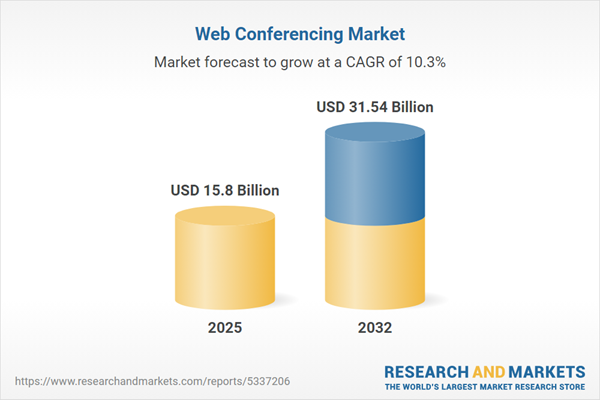Speak directly to the analyst to clarify any post sales queries you may have.
Web conferencing technology has become a vital catalyst for modern organizations pursuing comprehensive digital transformation. Senior decision-makers are steering their enterprises toward solutions that enable secure, seamless collaboration and support adaptable technology strategies, underpinning operational resilience in a rapidly changing business landscape.
Market Snapshot: Web Conferencing Market Growth and Opportunity
The web conferencing market expanded from USD 14.38 billion in 2024 to USD 15.80 billion in 2025 and is forecast to reach USD 31.54 billion by 2032, with a CAGR of 10.31%. This substantial growth is propelled by new work models that blend remote, hybrid, and in-office collaboration. Organizations are responding to heightened regulatory oversight and evolving user expectations regarding both security and functionality. As a result, investment is accelerating in scalable, cloud-first platforms that underpin digital transformation initiatives, supporting efficiency and business continuity across all sectors.
Scope & Segmentation: Strategic Options Across the Web Conferencing Value Chain
This report provides a thorough analysis of the web conferencing ecosystem, covering every link in the value chain and highlighting the segments shaping competitive dynamics and customer requirements across global markets.
- Component: Covers managed services, professional services, consulting, training and support, alongside software platforms, ensuring comprehensive support options for enterprises prioritizing reliability and expertise.
- Conferencing Type: Addresses audio conferencing, screen sharing and remote access, video meetings, webcasting, and webinars to support a range of communication and content delivery needs.
- Organization Size: Serves large, medium, small, and micro enterprises, reflecting the diverse demands for flexible and cost-effective collaboration solutions throughout various business scales.
- Device Type: Encompasses mobile devices, PCs and laptops, and tablets, supporting workforce mobility and consistent access across preferred endpoints.
- Deployment Type: Includes both cloud and on-premises models to ensure alignment with organizational IT strategy and regulatory mandates.
- Application: Spans education and training, enterprise communication, marketing and client engagement, remote support, sales and customer service, telehealth, and telemedicine for industry-specific and horizontal use cases.
- Industry Vertical: Incorporates key sectors such as banking, financial services, insurance, education, energy and utilities, government, healthcare, IT and telecom, manufacturing, media and entertainment, as well as retail and e-commerce.
- Regional Coverage: Includes in-depth analyses of markets in the Americas, Europe, Middle East and Africa, and Asia-Pacific, providing insights into localized adoption trends and regulatory drivers.
- Company Coverage: Reviews both global technology leaders and emerging competitors—including Adobe Inc., Cisco Systems, Google LLC, Microsoft Corporation, Oracle Corporation, Zoom Video Communications—offering a balanced view of the supplier landscape.
Key Takeaways: Strategic Considerations for Senior Leaders
- AI-powered features, immersive technologies, and usability enhancements are now expected as standard, shaping criteria for solution selection and contributing to superior workforce engagement.
- Hybrid workforce models require solutions to maintain performance, user experience, and security across every endpoint, reinforcing technology’s role in workforce enablement.
- Organizations are leveraging unified communications, platform consolidation, and extensible APIs to streamline operations and introduce advanced automation, supporting scalable business growth.
- Heightened security and regulatory requirements are influencing buyer preferences toward native encryption, zero-trust security frameworks, and transparent data practices.
- Competitive intensity is rising, with established global providers and agile challengers driving innovation in sectors such as telehealth and mobile collaboration.
- Careful evaluation of total cost of ownership and flexible deployment models is helping enterprises maximize technology ROI in a dynamic procurement landscape.
Tariff Impact: Navigating Hardware Procurement and Supply Chain Risks
Recent tariff changes in the United States have increased the complexity and cost structure of procuring web conferencing hardware, prompting organizations to shift toward cloud-centric collaboration platforms. Vendors with diversified manufacturing and responsive distribution are increasingly prioritized, while service providers are supporting the transition with flexible leasing and usage-based pricing to optimize spending and operational agility.
Methodology & Data Sources
This report’s findings are grounded in primary research with technology executives and product leaders as well as in-depth analysis of secondary sources, such as financial filings, regulatory materials, technical briefs, and industry conference presentations. Triangulation and scenario-based assessments provide reliable, actionable intelligence.
Why This Report Matters
- Enables executives to benchmark web conferencing strategies against shifting technology, regulatory, and competitive requirements.
- Offers essential insight into technology trends, emerging procurement risks, and strategic positioning across regions and industry sectors.
- Supports alignment of collaboration investments, workforce models, and compliance needs with future growth and resilience objectives.
Conclusion
Informed by this analysis, senior leaders can develop resilient collaboration strategies and accelerate sustainable digital transformation by adopting advanced web conferencing solutions tailored to evolving business challenges.
Additional Product Information:
- Purchase of this report includes 1 year online access with quarterly updates.
- This report can be updated on request. Please contact our Customer Experience team using the Ask a Question widget on our website.
Table of Contents
3. Executive Summary
4. Market Overview
7. Cumulative Impact of Artificial Intelligence 2025
List of Figures
Samples

LOADING...
Companies Mentioned
The key companies profiled in this Web Conferencing market report include:- Adobe Inc.
- AT&T, Inc.
- Avaya LLC
- Bridgit Inc.
- Cafex Communications Inc.
- Cisco Systems, Inc.
- Citrix Systems, Inc
- Communiqué Conferencing, Inc.
- Dialpad, Inc.
- Glance Networks, Inc.
- Google LLC by Alphabet Inc.
- International Business Machines Corporation
- Enghouse Systems Limited
- Microsoft Corporation
- Oracle Corporation
- QUOBIS NETWORKS, SLU.
- RHUB Communications, Inc.
- Windstream Communications Inc.
- Zoom Video Communications, Inc
- ZTE Corporation
- RingCentral, Inc.
- GoTo Technologies Inc.
- Verizon Communications Inc.
Table Information
| Report Attribute | Details |
|---|---|
| No. of Pages | 193 |
| Published | October 2025 |
| Forecast Period | 2025 - 2032 |
| Estimated Market Value ( USD | $ 15.8 Billion |
| Forecasted Market Value ( USD | $ 31.54 Billion |
| Compound Annual Growth Rate | 10.3% |
| Regions Covered | Global |
| No. of Companies Mentioned | 24 |









